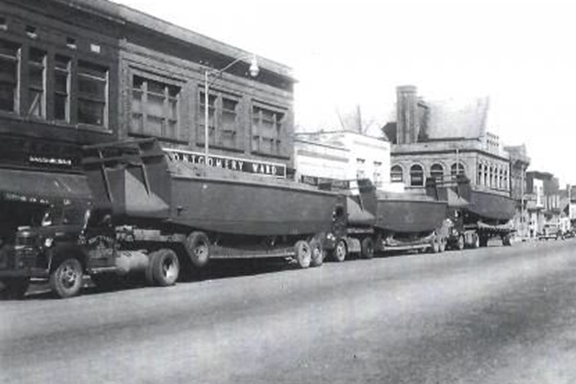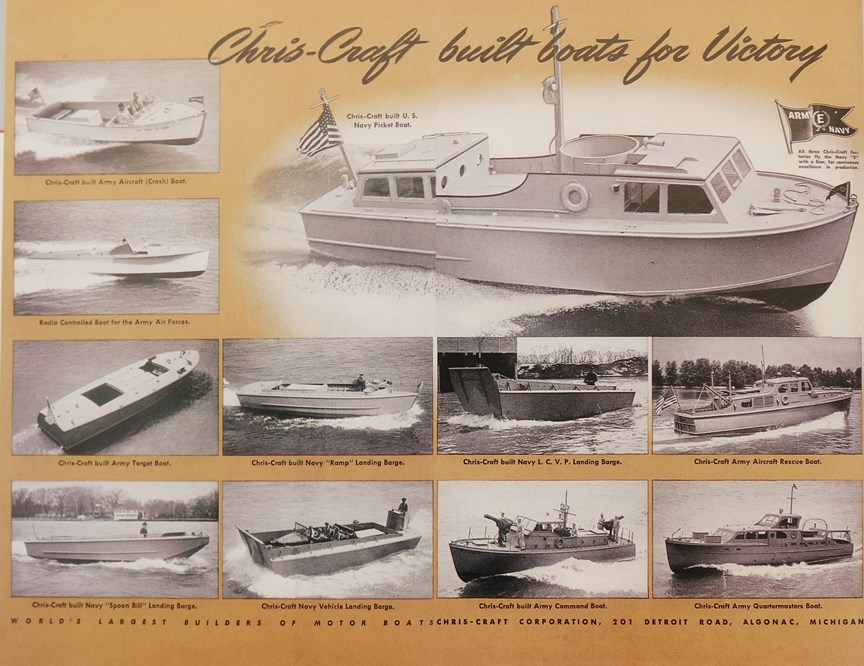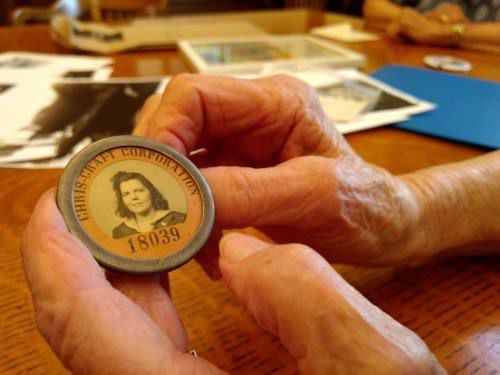
(US Auto Industry WW2)
Similar to the mass production of bombing planes and jeeps, boats, particularly landing craft, were an essential vehicle produced here in America for World War 2 efforts. As Chris-Craft of Algonac, MI started producing these vehicles in mass, their factories changed life in some small towns forever.
A Brief History
Chris-Craft is one of the most well-known luxury boat company based right out of the small town of Algonac, Michigan. The company was founded in 1910 by Chris Smith and began producing economically priced runabout boats for the masses. Chris-Craft was the largest employer in the town of Algonac right along the Saint Clair River, 30 minutes upriver from Detroit. In 1927, Chris-Craft was taken over by Chris Smith’s Son, Jay Smith, who would hold the leadership position for the next 31 years and transform the company into one of the largest producers of wooden powerboats.
The Chris-Craft company came on hard times during the Great Depression but luckily, they were able to restore the success of their company with the beginning of World War 2. Chris-Craft became the second-largest producer of landing craft for the United States Military and opened up two more plants in Holland, Michigan as well as Cadillac, Michigan.
With the creation of these huge production plants, the way of life in the relatively small towns changed forever. Factory workers flocked to the towns in the search of labor. With most of the men drafted or joining the military as war efforts escalated, Chris-Craft employed women, similar to other large war production plants. The idea of “Rosie the Riveter” stood strong in Algonac, Holland, and Cadillac. Women, mostly young, came from all over the Midwest seeking work in these plants.
The plant in Algonac built the larger boats like the Navy’s Picket Boat, which needed to be tested in the Saint Clair River before they were shipped off for use by the military. The Holland plant, which was also located along main waterways connecting it to Detroit, produced mainly landing vehicles that were used in the amphibious assault during D-Day in 1943. The Cadillac plant was not on main waterways and the boats needed to be shipped out of the small town; this plant also produced mainly landing craft.
Post-war, Chris-Craft continued their commercial success and is still in good business standing today. The towns of small-town America, those like Algonac, Holland, and Cadillac, were forever changed by the efforts of a single company. Women were empowered, we were introduced to the impact of industry on war, and similar towns across America were, for the most part, at the will of these production companies.
A Nation at War
On the day of September 16, 1940, the United States initiated the Selective Training and Service Act of 1940 which required all able-bodied men between the ages of 21 and 45 to register for the draft. This draft had a devastating immediate economic effect on both large- and small-scale businesses in many little towns across the country. Without men to work in the factories of production plants companies like Chris-Craft and Boeing reached out to women to fulfill these positions in order to carry out big government contracts for the war. With the men off to war, women came from far and wide to work in these large production plants for the war effort; and these plants, in turn, brought life to many small towns.
Chris-Craft, a producer of mahogany wood boats, was struggling to make its way out of the Great Depression, and now with a mandatory draft registration for all men, things were not looking good for the company based out of Algonac, MI. Luckily, the company was outsourced by the military for boat production during the war effort. Facing a hefty military contract, Chris-Craft opened two more plants in Holland and Cadillac and began seeking to fill holes in their workforce with women, just as larger companies had begun doing. The image of “Rosie the Riveter” rang true in many towns across rural America; especially in the towns of Algonac, Holland, and Cadillac.
Ruth and Ruby Samuelson
Eager to help the war effort, many women began looking for jobs in production plants, seeking to do any work necessary to help their American soldiers overseas. They were urged not only by propaganda and the Federal Government [2], they were also pushed by the overwhelming societal support of the war. Among them were Ruby and Ruth Samuelson. These twins left came to Cadillac, Michigan from Iowa in 1942 to both help the war effort and because their rural farm town offered them little work. [1]
The two rented out a small apartment and would walk to and from work at Chris-Craft every day. Surprisingly, they earned 75-cents an hour which was double that of the 1943 minimum wage of 30-cents and they worked 10-hour weekdays and 5 hours on Saturday. In the plant, the men would do the heavy lifting, putting up the side-hauls of the landing craft and other war-time sea craft, while the women carried out the more tedious work of screwing everything in place; the men of these factories were primarily elderly. Ruth and Ruby said they were never mistreated on the job and their crew was very respectful, proving how women were able to work alongside men efficiently when the environment encouraged it. The two did this for three years until the war’s conclusion in 1945 when the men came back. [1]
Women at War
Chris-Craft was the second-largest producer of the landing-craft used in the Normandy beach invasion, producing nearly 8,000 of them [5]. Their three production plants produced many other vessels to aid the ally war efforts as shown in the attached image below. Following the war, Chris-Craft returned to producing consumer-grade boats but had now won the respect of the American populous for their valiant efforts in the war. Their production plants brought not only a movement for workplace equality but brought economic growth both during and following the war and brought in more people into their small towns. Algonac, Holland, and Cadillac saw a growth economically and in population immediately following World War II [4], and along with this came a social growth for the woman equality movement. Women were no longer view as just the mother and home presence of the family of these rural towns but had proven that they were more than capable of putting food on the table and taking care of the family.

(US Auto Industry WW2)
Similar stories to that of Ruby and Ruth were heard around the country. Women helping the war effort and providing for their families in order to survive. Unlike Ruby and Ruth, however, many of the women trying to enter and stay in America’s work fore endured harassment, miserable working conditions, as well as low pay. Regardless, World War II proved to allow women to make strides in terms of equality. After showing that women were just as capable as men to support families, men could no longer claim superiority over women. Every state in America had their version of “Rosie the Riveter,” an image that continues to empower the equal pay movement to this day, just as Ruth and Ruby Samuelson were the “Riveters” of Michigan’s industrial war efforts. However, if it weren’t for America’s capitalistic socioeconomic state during this particular war, it is possible that such strides for equality could not have been made. The backbone of our military was our workforce, and this was only reinforced by competition in the industry.

(Cadillac News)
Victory by Production
Were did not win the war out of sheer manpower and tactics, rather our war was won with production. Our workforce was required to fulfill Roosevelt’s idea for America to be an “Arsenal of Democracy,” splitting the country’s efforts both overseas and in industry. Our goal of the war was to outproduce all our foreign enemies on an industrial scale. Our war-supporting society was essential for this to be accomplished; without the support of the media and social groups, the federal government had no way of accomplishing this. Companies across America competed against one another to have the opportunity to be outsourced by the American government to produce at a national level for the war effort. World War II was the first war the world had seen where outsourced resources through the means of capitalistic competition had played an exponential role in the victory. American industry provided about two-thirds of Ally’s military equipment during the war [5].
Competition is argued to be one of the leading causes of an American victory. Effectively, companies were not only in competition with one another at the Homefront, but they were also in competition with the Axial Power’s industry. As the German and Japanese forces continued to make technological strides in their quest for domination, America’s industry was responsible for continually matching if not overtaking their accomplishments. Such competition is what brought inventions like jet engines, nuclear power, and computers both into the military and consumer world [5].
However, in what started as simple competition in the industry, war production today was a grown point of Controversy. After World War II, our choice in who we go to war with was not centralized in a clear enemy threat to the American way of life. Instead, wars like the Vietnam War and our involvement in the Middle East do not seem to have as clear of a cause for involvement as well as very little societal support. It is argued that our involvement in foreign wars has shifted from directly protecting innocents to instead protect the industry, such as our quest for oil in the Middle East. However, the main factor that connects World War II with the following wars is the underlying involvement of American capitalism. Eisenhower warned us of the dangers of the industrial complex our military forces see today where large companies are now constantly in competition for the next big government contract. Where in World War II Chris-Craft and companies shifted from consumer products to military products for the main cause of assisting the war efforts, companies are now solely contracted out by the military for their effective and deadly weapons. This controversial shift in military support has been inversely proportional to our military’s social backing. Where people like Ruby and Ruth Samuelson went all the way to east-side Michigan from Iowa to support the war effort and FDR’s idea of the “Arsenal of Democracy,” support for our military today has dwindled in comparison.
A Small Town Changed
Companies like Chris-Craft, consumer-gone-military companies, thrived during and after the war after solidifying their image for their effort in the war. For their war efforts, Chris-Craft was awarded the Navy/Army “E” award which was presented to companies during World War Two of excellence in production [6]. After the war, Chris-Craft continued to succeed in boat sales and left awake in the small towns where it helped with the war efforts. There are still monuments in these towns commemorating Chris-Crafts impact [7]. Other war production companies that did similar work in terms of their war effort also saw, for the most part, commercial success in post-war America. Along with this economic success also came the popularization of some small towns across America.
To this day we continue to see this being replicated, small towns basically being built around the plant that is in them. Chris-Craft did it to Algonac, Holland, and Cadillac just as today companies like General Motors and Ford or sometimes even Amazon cause towns to rapidly grow with the construction of a new plant. Vice versa, when these companies leave, the lack of work causes the population to drastically drop, just as what happened in Janesville, Wisconsin when the GM plant shut down. There appears to be great power in the hand of large production companies, being able to shift populations of rural America at ease, and this also is correlated alongside production during World War II.
Conclusion

(The Voice News)
When Chris-Craft chose to help the war effort, they were unaware of the socioeconomic effect that it truly would have. Women like Ruby and Ruth Samuelson and countless others across the country had the ability to prove that women were truly capable of supporting either themselves or a family. Companies that had similar war efforts as Chris-Craft sparked the shift from full Home-front support to the industrial complex that can be observed in modern wars today. Small-town America, towns like Algonac, Holland, Cadillac, towns left out of history books were forever impacted from both sides of Roosevelt’s “Arsenal of Democracy.” Their men were going off to war, their women supported both the war effort and sometimes their families on the Home-front, and the towns saw a surge in population and economic well-being. Today, Algonac has returned to its rural small-town nature, except now the town is dotted with memorials of its war efforts both overseas and down the street in the Chris-Craft plant.
Primary Surfaces
- Suhs, Mardi. “Twins recall working in the Cadillac Chris Craft plant during WWII.” Cadillac News. 09/11/2018. Pages: All.
- War Manpower Commission. “If Hitler Came to Mobile.” United States Employment Service. (“If Hitler Came to Mobile“)
- Stateside Staff. “An interview with Rosie the Riveter.” Michigan Radio. 29/09/2013
Secondary Sources
- Rodengen, J. L. (1988). “The legend of Chris-Craft.” Fort Lauderdale, Fla: Write Stuff Syndicate.
- Mollica, A, & Smith, C. (2010). “Building Chris-Craft: Inside the factories.” Minneapolis, Minn: Quarto Publishing Group USA
- Gribbins, J. (2001). “Chris-Craft: A history, 1922-1942.” Marblehead, Mass: Devereux Books.
- Suhs, Mardi. “Chris-Craft Cadillac produced the landing craft for D-Day”. Cadillac News. 06/06/2018.

